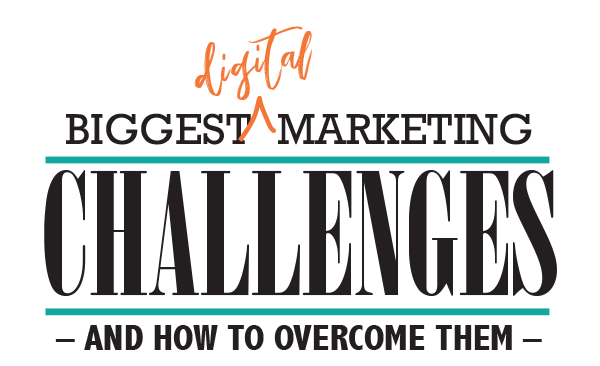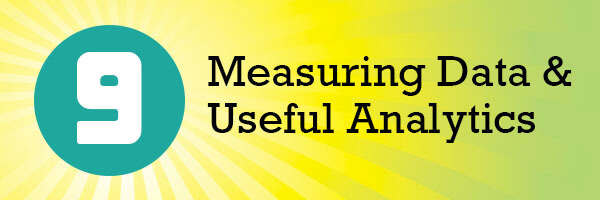

It has become imperative that businesses and nonprofits compete in the digital landscape in order to succeed – and survive. No longer is having a strong digital marketing presence a luxury for corporations and big businesses. As we saw over the last year, your digital marketing presence is extremely important to your survival when everything shut down and went digital. However, digital marketing is not without its challenges; some easier than others to overcome. What follows are some of the biggest digital marketing challenges facing small business and how to overcome them.
#1 – Generating Leads
Perhaps one the biggest, if not the biggest, digital marketing challenges facing small businesses is finding new customers – but not just someone who might buy from you and never see them again – repeat customers – also known as quality leads. Quality leads are tough to come by. And, vetting leads takes time and effort. Using a CRM can help, especially if you have marketing automation setup. But, it takes more than some really sophisticated and helpful tools to generate quality leads.
To generate quality leads consistently, you first need to know what a “quality lead” means to you – how much does the lead need to spend to be considered a “quality” lead? How long do they need to be a customer? What does their persona look like? Defining your ideal customer goes a long way toward determining how to foster that kind of business-to-customer relationship.
Many businesses and nonprofits don’t have their ideal customer defined – they know what they do, their mission, vision – all of that – but they don’t have their ideal customer defined and fleshed out. Without knowing what your ideal customer looks like – what a quality lead means to you – how can you tell what a quality lead versus a non-quality lead is?
Once you’ve got your ideal customer(s) defined – you could have a few different personas depending on who your serve – you need to think about where you would reach these people – social media, on the internet, search engines, traditional marketing, email, etc. In order to generate quality leads, it requires a great deal of up front work and planning before you can turn on your lead generation machine and let it run.
There are a variety of methods of generating quality leads. Developing a social media marketing strategy is an important part of that mix. The average user spent 2 hours and 24 minutes a day on social media last year. While social media is a great place to start collecting leads, even more importantly, it’s a great place to start building relationships with potential customers. According to Motista, customers with an emotional relationship with a brand have a 306% higher lifetime value and will recommend the company at a rate of 71%, rather than the average rate of 45%.
Building relationships with customers is typically a longer conversion game than other types of marketing, however, the payoff is much better. Quality leads don’t happen overnight. Only 4% of website visitors are ready to buy at that moment – the other 96% will require lead nurturing and B2C relationship building before they are ready.
Generating quality leads is a marathon, not a sprint. Converting interested leads into customers will take time and effort, however, with the use of marketing automation and/or a CRM, the work may not be so bad. Be clear in your goals and specific in your target audience definitions and you’ll experience an easier lead generation process.
How to get Target Audience Data
- Surveys
- Research
- Engage them on social media
- Frequent check-in calls with customers
- SEO metrics & analytics
Consider shifting your customer generation methodology to be customer-centric – STOP guessing at the content your customers and potential customers want to see and actually KNOW. This means analyzing personas, finding their pain points and where they may be in the buyer journey.
#2 Knowing Your Target Audience
Before you can effectively generate quality leads, you need to know who your target audience is. This is a challenge because your target audience may not be a single demographic; rather you could be serving multiple personas, demographics and customer types. But knowing who your target audience is is vastly different then knowing your target audience. That is, knowing that they want, what they need and meeting their expectations.
Many businesses struggle with meeting customer expectations – especially online. In fact, getting them to engage with your brand and its content can be seemingly impossible. The challenge is usually sharing the right content for your target audience to engage with, realizing that not everyone in your target audience is going to engage with every piece of content you share. This is where having a content marketing strategy is important.
Content marketing is arguably cheaper than SEM or PPC marketing and provides multiple opportunities for users to engage with your brand. But, in order to be effective with your content marketing, you need to know your target audience. Sharing content that they don’t care about or won’t engage with isn’t going to help your brand much at all. So, how do you get to know your target audience?
Asking questions. Requesting feedback. Inviting customers to take surveys. Engaging with them on social media. These are all ways that your brand can get to know your target audience better. Once you know more about them, implement your new found knowledge into meaningful, relevant content. In short, listen more than you speak.
Knowing your target audience and what they expect from your business (especially online) can be challenging. And just as all users aren’t created equal, everyone has different needs and expectations. Knowing how your target audience communicates, where they hangout online, how they prefer to be reached are important to your digital marketing strategy.
#3 Developing a Content Marketing Strategy
Developing a content marketing strategy is something every business or organization should do – and, arguably, that might cross over with your social media marketing strategy and other marketing initiatives. Most businesses, however, don’t really know where to start. To develop a content marketing strategy, you need to know what content is considered valuable to your target audience and then, how you will share it.
For businesses and nonprofits that don’t already have content to share – blog posts, industry news, podcasts, videos, etc., creating a content marketing strategy can seem daunting. In fact, it may seem impossible especially if you have no prepared content. The first step in a content marketing strategy is knowing your target audience, which we just went over. Next, you should determine what content you have already AND if any of that content would be considered valuable to your target audience. If so, develop a plan to share it.
Sharing your content should really be a matter of pushing out your prepared content to all of your marketing channels – social media, your blog, your website, etc. You will need to determine, however, if certain content should be shared with one channel and not another depending on your audience’s expectations. For instance, if your audience is younger, you wouldn’t share content targeted towards a middle aged and senior target audience. Share only the content that your target audience will find valuable on a given channel.
The big secret to content marketing is repurposing content. For instance, a blog post can be broken down into multiple social media posts (and vice versa) and reshared. A group of related blog posts could be combined into a single digital resource that can be used to collect leads. A video course can be broken down into a series of nurture emails for those who showed interest but didn’t attend. Keep in mind that every piece of content shared doesn’t have to be brand new. In fact, resharing an older piece of content can provide new life to a previously published post.
The last part of developing a content marketing strategy is creating a plan – a schedule – so that you can setup your content to publish without having to actually publish it at that time. There are a bunch of scheduling tools out there – I particularly like MailChimp and Hootsuite for social sharing. Once your content is prepared, schedule it and get it published to your marketing channels for your target audience!
#4 Budgeting for PPC & What Ads to Run
Determining a budget for pay-per-click ads has always been a challenge. There’s no really magic number when it comes down to budget on PPC ads – it largely depends on your goals (IE conversions, increasing your audience, email newsletter signups, website traffic, etc.) and how much you’re willing to spend to reach those goals (IE CPA cost per acquisition, how much a new customer is worth to you, etc.) In order to know what you should budget for a PPC campaign, you have to have clear, measurable goals, the keyword being “measurable”.
If you aren’t able to measure the goal of a PPC campaign, you’ll have no idea if it’s successful. For instance, if your goal is to increase website traffic, you have to set know what your web traffic was previously and set a goal like 25% more web traffic and a time period for the goal, like in a month. Without these three things, you can’t measure anything and thus, can’t determine whether a campaign has been successful.
As far as the length of any PPC campaign unless you’re just testing an idea or concept, you should not run a campaign for anything less than 30 days for a couple reasons. First, on any platform, Google, social media, etc., it takes up to a week for the platform to reach the majority of your audience because there’s no data or performance history. In fact, it is recommended that any PPC campaign run at a minimum for 3 to 6 months and up to 12 months for strong campaign results. Obviously, a 12 month PPC campaign would take some pre-planning and budgeting, but wouldn’t you do that with any campaign?
According to Google, it’s said that for every dollar that a business spends on Google Adwords, it makes an average revenue of $2. The average cost-per-click across all industries in Google AdWords on the search network is $2.69, according to Wordstream. That said, you can probably determine your budget based on that average, the length of the campaign and your goals. One other thing to mention so that you have barometer for the industry with the highest average click-through rate is the dating and personals industry, while the lowest click-through rate is found in the legal industry.
As far as the ads to run is concerned, again, it depends on your goals and your audience. If you have a large following on social media, it would be wise to put more budget on social media PPC ads. If you’re looking to retarget people who have visited your website, the Google Display Network (GDN) is probably a better use of ad spend. It’s important to consider the whole campaign and the idea conversion flow so that you can accurately set a budget rather than just planning to run PPC with other marketing media and no plan on how they will work together. Can you run more than one type of PPC ad at the same time? Absolutely! In fact, that’s highly recommended as part of a multichannel marketing approach.
For instance, if you’re reaching out to your current customer base via email about a new promotion you’re running for next month, you’d want to create a landing page for the promotion, send out the email driving them to the landing page, retarget them on whatever network(s) seem appropriate and setup marketing automation to make sure no leads are left behind. This may be an over-simplification of a potential campaign, but you can see the minimal use of PPC ads to make the campaign successful. In this instance, using PPC ads is a method of retaining the people who visited the landing page, and not a widespread ongoing ad campaign to your entire audience.
A few more things to consider:
- More than half of all searches are longer than four words (Wordstream).
- The most expensive keyword is “insurance” (PowerTraffick).
- The industries spending the most on PPC advertising in 2018 include retail, travel, publishing and education. The consumables, automotive and home improvement industries are spending the least on PPC advertising.
- The most effective PPC channels are text ads, remarketing and mobile.
- Google AdWords, Facebook and mobile are the most popular PPC platforms.
- More than 40 percent of clicks go to the top three paid ads in search results (Wordstream).
- 90 percent of consumers say they trust online reviews (Google).
- The average cost-per-action across all industries in Google AdWords on the search network is $48.96. Cost-per-action is highest in the technology industry at over $133. Cost-per-action is lowest in the auto industry at $33.52.
- The average conversion rate across all industries in Google AdWords on the search network is 3.75 percent. Conversion rates are highest in the dating and personals industry at over 9 percent. Conversion rates are lowest in the advocacy industry at 1.96 percent.
#5 Creating Content People Want
Perhaps the ages old question of knowing what people – consumers, potential customers and current customers – want to see from your business or organization. As old as business itself, how do you know what people want from your business if they aren’t A. buying something from you currently or B. intend to buy from you in the future? The answer to this requires some analysis and even some customer feedback, too.
You should have an idea of how people – specifically your customers – find you – whether it’s from a blog post that they found while searching, on social media, either recommended from a friend or via a post, an ad on radio or tv, or on the Google Display Network – however it is that they found you – you should have some idea – that is, if you had tracking setup for that kind of thing.
Tracking doesn’t need to be this complicated, code-driven thing that you place on your website. It doesn’t even need to be digital. You can ask in-person at the time of a transaction or filling out a form (either online or on paper). Some places use specific coupon codes depending where the consumer gets the coupon from to help track the number of redemptions. However you do it, you should have a method of tracking.
Tracking tells you a bunch of things. First off, it tells you how the consumer found you (at least in terms of a transaction or conversion). If you have a CRM setup, it might tell you more based on their visits to your website after they’ve completed a form, revealing all the pages of the website that they visited before they reached out. This tells how what content they consumed before deciding that they wanted to make a purchase.
Tools like Google Analytics will tell you what your most popular pages and posts are – and from that you can tell what content people consume most. If it gets multiple visits, it’s content people are interested in. Check out Google Search Console also – assuming you’ve submitted your site there – that has valubable information that includes what people have searched for, how you’ve ranked and when people have clicked. From there, it’s about creating additional content that is similar in nature but new.
You can also check what’s trending for searches on Google – this can be a help to see what people are searching for and determine if your producing content that’s part of that. It’ll product metrics similar to Google Analytics about trending articles and topics that are trending geographically to help you create content that will piggy-back off of that content.
What is a “Freemium”?
There are many ways to introduce and market new products and services – offering a free trial, a discounted trial period, money back guarantees, no contract/cancel anytime policies – there are a bunch of different ways to get a consumer or business to “try out” what you’re offering. Most of the time, businesses find themselves “giving away” their products and services – just for a free trial – that may never convert or TURN INTO A PURCHASE.
There’s actually very little value in “free” product trials and services. While people get to try out what you’re offering, more or less risk-free, there’s no incentive for them to stay with you at the end of the trial period or after the product has been used. How do you combat that? With a freemium.
In a freemium business model, customers are able to signup or download an app for free, however, they are offered upgrades and purchases for premium features, additional content or digital goods. The idea is to lower the entry barrier for people to sign up, to help lower your customer acquisition cost (CAC), to begin establishing a relationship based on trust as they begin to learn and use your product or service. Learn more >
#6 Going Multichannel or Omnichannel
Multichannel marketing and omnichannel marketing are not the same, though many use them interchangeably. Omnichannel marketing refers to a marketing method where the same marketing message, branding and imagery is used to communicate a brand’s message across multiple channels. Multichannel marketing is used when different messages are required to reach multiple audiences across different channels. The choice to use one or the other usually comes down to the effectiveness of a given campaign.
For instance, if the goal of a given campaign is to communicate a single message, for instance an offer or a sale, then an omnichannel approach would be appropriate. If your purpose is to engage users to get them to make a purchase, then perhaps an multichannel approach is more effective. The reason being is that people buy for different reasons. For a general buying campaign, you’re attempting to reach several different personas and different incentives encourage them to buy, whereas when you have a sale or offer, you have one sales event you’re guiding them towards, leading them toward a certain end goal.
You really need to determine at the beginning of a campaign whether it’s going to be multichannel or omnichannel. It’s just not effective to determine that late in the campaign. Many factors can determine whether your campaign will be multichannel or omnichannel. In addition to having a single sale with a particular offer, an omnichannel campaign might including guiding the consumer or business to a freemium or introductory offer, with an option to upsell in the future. Having a freemium is a low barrier way to introduce them to your products/services and offers the possibility for an upsell in the future.
#7 Creating Mobile First & Responsive Content
A good rule of thumb is to start designing or creating content for mobile devices first. That is, in a one column format where it requires lots of scrolling with a finder or stylus. Why? For starters, that’s going to be the most challenging and if your content works on mobile, it’ll definitely work on desktop. Things like making sure elements aren’t too close together (like buttons and links) and images and graphics being large enough to see (typically horizontal graphics don’t work well on mobile because of how content responds to the screen size) are important to consider when creating mobile first content.
You might say “you could turn the phone sideways and then the content would be big enough”. You can’t count on that. If consumers get on your page and the content doesn’t respond and is unenjoyable – yes, unenjoyable – they’ll bounce and find another site that did consider responsive, mobile-first design.
This really goes for any content you’re creating – social posts like LinkedIn articles, email marketing campaigns, blog posts – virtually any and all content that can or will be viewed on a mobile device. The same principles apply. Typically mobile users are looking for information fast, so allowing them to find it and take action is key with mobile first design.
A few more things to consider:
Here are some tips to watch for when creating responsive content:
- Make sure your text is easily readable without zooming in.
- Make sure your content is large enough so that users don’t need to turn their device horizontally to see it.
- Make sure links are spaced enough apart that it’s easy to tap with a finger.
- Make sure you’re not using Flash or another software that doesn’t work on mobile devices.
- Make sure your page loads quickly – use this speed test to check.
#8 Promoting Brand Awareness
Promoting brand awareness is probably one of the biggest digital marketing challenges because you wouldn’t be trying to generate leads if you weren’t trying to promote awareness of your brand. Promoting brand awareness itself isn’t difficult, however to do it successfully can be challenging.
Brand awareness isn’t exactly hard, however, creating actionable brand awareness geared content can be a challenge if you don’t have a lot of content to begin with. Depending on your brand’s history, whether you’ve been around for decades and are making a brand shift or if you’re just starting out with an entirely new brand, you’ll want to promote your brand differently. For instance, if your brand is new and something no one has ever heard of, you’re going to do a lot of introductory content – explaining who you are, what you do and why you’re different. On the other hand, if you’re an established brand making a shift in what you do or how you do it, you may not have to work so hard to build a following; rather, just communicate clearly what has changed and why.
Promoting brand awareness requires a multichannel or omni-channel approach. To promote your brand successfully and to reach your entire audience, all of your channels must be utilized. Yes, it’s an enormous amount of work. But, yes, it is worth it. Utilizing all of the tools at your disposal to promote your brand requires a lot of work upfront – determining a strategy, scheduling campaigns and creating places for your audience to engage with your brand.
There’s no right or wrong approach here – just that you need to set measurable goals, create a strategy and execute. By now, you should be able to tell how important it is to set your goals at the start and determine a strategy upfront. If not, go back through and read the first few points in this list again.
#9 – Measuring Data & Useful Analytics
Once you’ve got everything setup, you need to measure your results – how else will you know how well your digital marketing is doing? Depending on the platform(s) you’re using, you may have multiple dashboards that are reporting results, which isn’t uncommon. The important thing is that the results of your campaigns are being measured – and learned from. After all, if you’re not acting on the data you receive from your campaigns, why are your measuring it?
More importantly, what are you trying to measure? Are you using the right tools for the job? For instance, Google Analytics is a great tool for measuring tons of data – traffic, behavior, conversions, demographics, acquisition – a virtual treasure trove of information. However, do you know where to find the data that actually means something to you? Do you know how to interpret the analytics that Google Analytics (GA) provides? Or is GA not really enough to meet your data needs?
I rely on a few different tools for data measuring – Google Search Console works in conjunction with Google Analytics and fills in some of the gaps where Google Analytics falls short. For Worpdress users, Monster Insights is a plugin that syncs data from both Google Analytics and Search Console into a plugin in your WordPress site that is easy to read and gives you the most important information quickly.
Additionally, I use other tools that have some great analytics – MailChimp for email marketing (it’s a great CRM too), HubSpot for a more comprehensive CRM and marketing experience, and Bonterra (formerly Salsa) for assisting nonprofits with fundraising and advocacy efforts. All of your social media platforms, such as Facebook and LinkedIn, have metrics that measure engagement with business pages, post reach, advertising and more. Knowing what each platform provides in terms of data is important and being able to interpret the data is essential to acting appropriately with your campaigns.
Make sure your goals are measurable, as I’ve said before. If you can’t measure it, you won’t know if it worked. Or if it didn’t work. If you can measure it, determine the most important metrics that can be measured. For instance, if your goal is to increase sales over the next 6 months, measuring the number of followers you’ve gained or site visits you’ve received, isn’t going to help. However, if you’re measuring conversions and recording how much each conversion brought in in terms of sales, then those are important metrics and are worth measuring.
Something to think about…
Analytics and data is great. Remember that your analytics can only piece together part of the story; that is, unless you know exactly what your website visitors and customers are actually thinking, you won’t have the final piece of the puzzle: intent.
I’m not downplaying the need for analytics and data – analytics and data are important in that they provide hard evidence as to the actions taken by your online visitors, which is imperative to determining intent. However, without knowing the intent of a user’s actions, you won’t really know how to optimize your site or a user’s experience.
This leads to a methodology called customer led growth. Customer led growth (or CLG) uses real user data by polling, surveying and interviewing website visitors and customers about their experience with your product/service and their journey towards finding a solution to their issue.
#10 – Staying Current on Changing Digital Marketing Trends
Staying on top of the current digital marketing landscape is challenging, in part because it’s constantly changing given new privacy laws, breakthroughs in technology and consumers reactions to marketing tactics. However, scientists don’t stop researching and experimenting because science continually changes, so why should digital marketers give up based on a constantly evolving field? The key to staying current is being in a constant state of learning.
There’s a lot of data out there and a lot of opinions about how digital marketing will change in the next year, 5 years and decade. In fact, Google said that they were doing away with cookies as early as 2023! And what the heck are FloCs? These are some of the very important changes coming to digital marketing in the near future AND they’ll likely change digital marketing as we’ve come to know it.
How do you stay in the know? Follow sites like Search Engine Land and Moz. Use hashtags to follow digital marketing topics on LinkedIn. Signup for Think with Google – a daily email list that highlights insights and ideas gathered from marketers around the world to help create a more informed community of digital marketing professionals. The important takeaway is this: stay informed by a trusted resource. Google is a pretty solid digital marketing resource. Moz has come to be known as a solid resource for SEO and content marketing. There are many resources out there – some are merely opinions or reposts of previously published content by more reputable sources. Find a resource and follow them. Not like a stalker though, that’d be weird.
Staying current on digital marketing trends is much the same as any professional who needs to keep their skills sharp by personal development. It takes hard work – above and beyond the work you do for others. Be like a digital marketing olympian. It’s definitely worth it.
These are just the top 10 digital marketing challenges facing small businesses (and nonprofits). As you can see, it takes a lot of work to overcome them all. If you’re a small business owner, my suggestion to you is to find someone you trust who knows digital marketing or has the capacity to learn it and work with them to overcome your business’s digital marketing challenges. If you do have the time and you want to learn, in addition to your business, godspeed.
Digital marketing is as much interesting as it is a challenge and I applaud anyone who decides to try and understand how it works, why they should care and how it’s changing. If it’s no in your wheelhouse, that’s ok too. The important thing is knowing whether you can or can’t do it yourself and if you can’t, asking for help.










